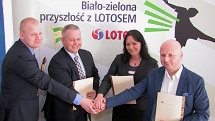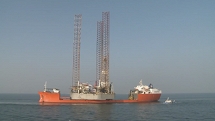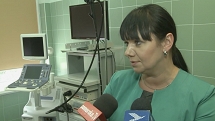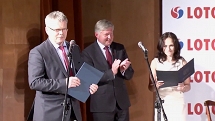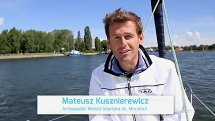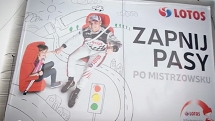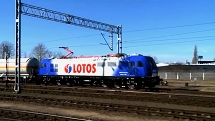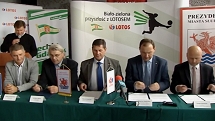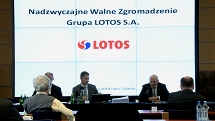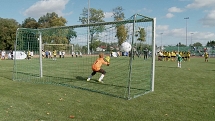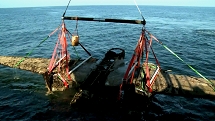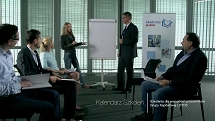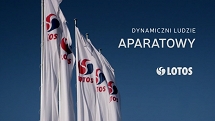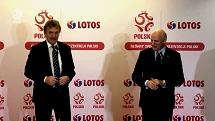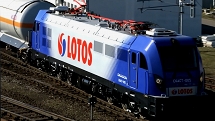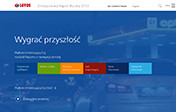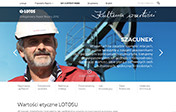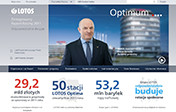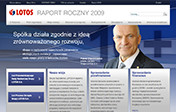-
Financial information
The past year ushered in a series of challenges for the companies in the fuel sector. The decisions made by us have demonstrated that we are able to take rapid steps to adapt to a demanding environment and ensure the desired profitability for our projects.
-
Segment performance
The segmental management model we have implemented enhances management efficiency, delivering cost and revenue synergies across the organization.
-
Letter from the Vice-President of the Board
2014 ushered in a series of challenges for the companies in the fuel sector. The decisions made by the LOTOS Group have demonstrated that we are able to take rapid steps to adapt to a demanding environment and ensure the desired profitability for our projects.
-
Business environment
The key factor that had a strong impact on both the global and Polish petroleum markets in 2014, with significant consequences for the LOTOS Group’s performance, was the price of crude oil, which also determined the price of petroleum products.
-
Strategic objectives
The LOTOS Group’s Strategy is designed to strengthen our position as a strong, innovative and efficient business which plays a major role in ensuring national energy security.
-
Business model
Our operations consist in crude oil production and processing, as well as wholesale and retail sale of petroleum products, among which are: fuels (unleaded gasoline, diesel oil and light fuel oil), heavy fuel oil, bitumens, aviation fuel, naphtha, propane-butane LPG and base oils.
-
Risk and opportunities
At the LOTOS Group, we identify a range of diverse risks, which may affect all areas of our business. The key risks in terms of their impact on our operations are the financial risks as well as risks affecting the exploration and production area. In the analysis of the risks, we also factor in issues related to sustainable development.
-
Key data 2014
With revenue of ca. PLN 28.5bn in 2014, we rank fourth in the group of 500 largest businesses in Poland.

← Statement Notes index
3. Basis of preparation
These consolidated financial statements (“consolidated financial statements”, “financial statements”) were prepared in accordance with the International Financial Reporting Standards (“IFRS”) endorsed by the European Union which were in effect as at December 31st 2014. Given the ongoing process of implementation of the IFRSs in the European Union and the scope of the Group’s business, as far as the accounting policies applied by the Group are concerned, there is no difference between the IFRSs which have come into force and the IFRSs endorsed by the European Union for 2014, save for the principles which have been modified or introduced as a result of applying new IFRS regulations for annual periods beginning on or after January 1st 2014 (see Note 4).
The following new standards, amendments to the existing standards and interpretations which have been endorsed by the European Union (the “EU”) are effective in periods beginning on or after January 1st 2014 and have been applied by the Company:
- IFRS 10 Consolidated Financial Statements (effective for annual periods beginning on or after January 1st 2013; in the EU effective for annual periods beginning on or after January 1st 2014),
- IFRS 11 Joint Arrangements (effective for annual periods beginning on or after January 1st 2013; in the EU effective for annual periods beginning on or after January 1st 2014),
- IFRS 12 Disclosure of Interests in Other Entities (effective for annual periods beginning on or after January 1st 2013; in the EU effective for annual periods beginning on or after January 1st 2014),
- IAS 27 Separate Financial Statements, as amended in 2011 (effective for annual periods beginning on or after January 1st 2013; in the EU effective for annual periods beginning on or after January 1st 2014),
- IAS 28 Investments in Associates and Joint Ventures, as amended in 2011 (effective for annual periods beginning on or after January 1st 2013; in the EU effective for annual periods beginning on or after January 1st 2014),
- Amendments to IAS 32 Financial Instruments: Presentation: Offsetting Financial Assets and Financial Liabilities (effective for annual periods beginning on or after January 1st 2014),
- Amendments to IFRS 10, IFRS 11 and IFRS 12 Transition Guidance (effective for annual periods beginning on or after January 1st 2013; in the EU effective for annual periods beginning on or after January 1st 2014),
- Amendments to IFRS 10, IFRS 12 and IAS 27 Investment Entities (effective for annual periods beginning on or after January 1st 2014),
- Amendments to IAS 39 Novation of Derivatives and Continuation of Hedge Accounting, published on June 27th 2013 (effective for annual periods beginning on or after January 1st 2014),
- Amendments to IAS 36 Recoverable Amount Disclosures for Non-Financial Assets, published on May 29th 2013 (effective for annual periods beginning on or after January 1st 2014),
Application of IFRS 11 Joint Arrangements had a material impact resulting in a change of the Group’s accounting policies described in the consolidated financial statements for 2013 (in particular in Notes 7.11 and 7.30). The standard replaced the previously applicable IAS 31 Interests in Joint Ventures and SIC-13 Jointly-controlled entities – Non-monetary contributions by venturers.
IFRS 11 defines a joint arrangement as an arrangement of which two or more parties have joint control, which exists only when decisions about the relevant activities require the unanimous consent of the parties sharing control.
IFRS 11 distinguishes two types of joint arrangements: joint operations and joint ventures. The classification of a joint arrangement as a joint operation or a joint venture depends upon the rights and obligations of the parties to the arrangement.
If under the joint arrangement the parties with joint control of the arrangement have rights to the net assets of the arrangement, then it is a joint venture, which in principle requires the establishment of a separate vehicle. As at December 31st 2014, the Group’s joint ventures included LOTOS – Air BP Polska Sp. z o.o., a jointly-controlled entity operating in the downstream segment, and the following entities operating in the upstream segment: Baltic Gas Sp. z o.o., Baltic Gas spółka z ograniczoną odpowiedzialnością i wspólnicy sp.k., and UAB Minijos Nafta.
As of January 1st 2014, all joint arrangements that meet the definition of a joint venture are equity-accounted. Under IFRS 11, proportionate consolidation, applied in past periods, is no longer allowed. For a description of the rules of equity-accounting for interests in entities and of proportionate consolidation (no longer in use), see Note 7.11 to the consolidated financial statements for 2013.
In these consolidated financial statements prepared as at December 31st 2014, the Group accounted for the interests in UAB Minijos Nafta, as well as LOTOS-Air BP Polska Sp. z o.o., Baltic Gas Sp. z o.o. and Baltic Gas spółka z ograniczoną odpowiedzialnością i wspólnicy sp.k., using the equity method (in approved financial statements for periods ending before January 1st 2014, the interests in UAB Minijos Nafta were accounted for with the proportionate method).
Joint arrangements under which the parties with joint control of the arrangement have rights to the assets, and obligations for the liabilities, relating to the arrangement, are defined as joint operations. As at December 31st 2014, the Group held interests in joint operations in the upstream segment through LOTOS Exploration and Production Norge AS of Norway, a company of the LOTOS Petrobaltic Group.
In accordance with IFRS 11, the Group recognises its interest in assets, liabilities, costs and expenses related to its joint operations in Norway, as reflected in relevant items of these consolidated financial statements. Before January 1st 2014, the operations in Norway were accounted for in accordance with the rules applicable to joint ventures within the meaning of IAS 31 as jointly controlled assets and liabilities (see Note 7.30 to the consolidated financial statements for 2013). The application of IFRS 11 did not result in any restatements or change in the Group’s comparative data related to these operations as the existing and previously applicable IFRS requirements concerning accounting for such jointly controlled activities are similar.
Regardless of the changes in accounting policies under the new IFRSs introduced as of January 1st 2014, given that the reporting period ended December 31st 2014 was the first period when the Group recognised revenue from sale of crude oil and natural gas in Norway, the Company selected and approved new accounting policies to measure and account for such revenue (see Note 7). The relevant revenue generated in the reporting period was derived from sales of natural gas produced from the Skirne, Vale and Atla fields, interests in which were acquired by the Group on December 30th 2013 (see Note 13 to the consolidated financial statements for 2013 – Acquisition of interests in Norwegian production and exploration licences − Heimdal).
These consolidated financial statements have been prepared on the assumption that the Group companies will continue as a going concern in the foreseeable future. As at the date of approval of these financial statements, no circumstances were identified which would indicate any threat to the Group companies’ continuing as a going concern.
The Parent’s functional currency and the presentation currency of these consolidated financial statements is the Polish złoty (“złoty”, “zł”, “PLN”). These consolidated financial statements were prepared in thousands of złoty and, unless indicated otherwise, all amounts are stated in thousands of złoty.
The Notes to the consolidated financial statements are an integral part of the statements.
(This is a translation of a document originally issued in Polish)






